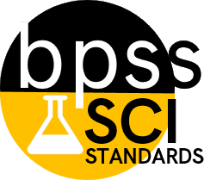SCI-07.2 Standard 2: Science Inquiry
Standards are larger groups of related benchmarks. So the Standard Score is a calculation of all the related benchmarks. |
|
SCI-07.2.01
Science Targeted Benchmarks
Standard 2: Science Inquiry
SCI-07.2.01 Communicate the results of scientific investigations using an appropriate format (e.g., journals, lab reports, diagrams, presentations, discussions)
7.2a -- Explain the components of a scientific investigation
7.2b -- Use appropriate tools and techniques to gather and analyze data
|
Student Learning Targets:
Knowledge Targets
- I can identify the components of a scientific investigation (ex. hypothesis, observation, data collection, data interpretation, communication of results, replicable).
Reasoning Targets
- I can explain the components of a scientific investigation (ex. hypothesis, observation, data collection, data interpretation, communication of results, replicable).
Skills Domain (Performance) Targets
- I can use appropriate tools to gather and analyze data.
- I can use appropriate techniques to gather and analyze data.
Proficiency Scale
| Score |
|
Description |
Sample Activity
|
| 4.0 |
The student demonstrates in-depth inferences and applications regarding more complex material that go beyond end of instruction expectations. |
-Done independently and consistently, connects to real world or other content areas |
| |
3.5 |
The student demonstrates in-depth inferences and applications regarding the more complex content with partial success. |
| 3.0 |
“The Standard.” The student demonstrates no major errors or omissions regarding any of the information and processes that were end of instruction expectations. |
- |
| |
2.5 |
The student demonstrates no major errors or omissions regarding the simpler details and processes (Score 2.0 content) and partial knowledge of the more complex ideas and processes (Score 3.0 content). |
| 2.0 |
The student demonstrates no major errors or omissions regarding the simpler details and processes but exhibits major errors or omissions regarding the more complex ideas and processes (Score 3.0 content). |
- |
| |
1.5 |
The student demonstrates partial knowledge of the simpler details and processes (Score 2.0 content) but exhibits major errors or omissions regarding the more complex ideas and procedures (Score 3.0 content). |
| 1.0 |
A partial understanding of some of the simpler details and processes and some of the more complex ideas and processes, or received help. |
- |
| |
0.5 |
Little or no understanding of the 2.0 or 3.0 content. |
Resources
Websites
Vocabulary
- hypothesis
- observation
- Independent variable
- Dependent variable
- Control
- Constant
|
|

